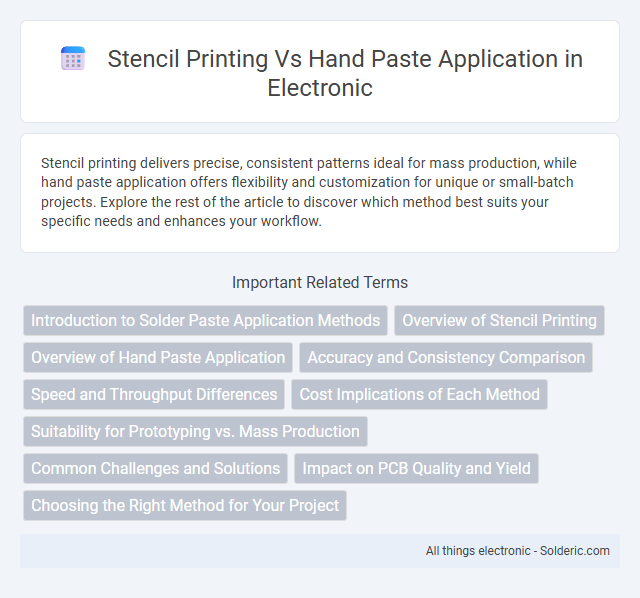Stencil printing delivers precise, consistent patterns ideal for mass production, while hand paste application offers flexibility and customization for unique or small-batch projects. Explore the rest of the article to discover which method best suits your specific needs and enhances your workflow.
Comparison Table
| Aspect | Stencil Printing | Hand Paste Application |
|---|---|---|
| Method | Automated or semi-automated screen or stencil to apply uniform paste | Manual application of paste using tools like spatulas or brushes |
| Precision | High accuracy and consistent pattern replication | Lower precision, variable depending on skill |
| Speed | Faster for batch processing and large-scale applications | Slower, time-consuming for large areas |
| Repeatability | Excellent repeatability with minimal variation | Inconsistent repeatability due to manual variance |
| Cost | Higher initial investment for stencil creation | Lower upfront cost, but higher labor costs |
| Application Types | Best for uniform layer thickness and complex patterns | Suitable for small-scale or custom jobs with less complexity |
| Material Waste | Minimal material waste due to controlled application | Potentially higher waste due to manual handling |
Introduction to Solder Paste Application Methods
Solder paste application methods are critical in PCB assembly and primarily include stencil printing and hand paste application. Stencil printing offers precise, high-speed deposition of solder paste through metal apertures, ensuring consistent volume and placement for automated processes. Your choice between these methods impacts assembly quality, with hand paste application suited for low-volume or rework tasks requiring manual control over paste amount and positioning.
Overview of Stencil Printing
Stencil printing involves applying ink or paste through a pre-cut template to create precise, repeatable patterns on various surfaces, making it highly efficient for mass production. This technique offers superior accuracy and consistency compared to hand paste application, which relies on manual skill and tends to produce more variability. Stencil printing is widely used in electronics manufacturing, textile decoration, and graphic arts due to its speed and ability to handle fine details.
Overview of Hand Paste Application
Hand paste application involves manually applying adhesive or paste onto surfaces using tools such as brushes, rollers, or spatulas, providing precise control over thickness and placement. This method is particularly effective for small-scale projects or intricate designs where stencil printing may not offer the required accuracy. Hand paste application allows for flexibility in handling various materials and textured surfaces, making it suitable for customized or artisanal production processes.
Accuracy and Consistency Comparison
Stencil printing provides superior accuracy and consistency compared to hand paste application due to its precise control over paste placement and thickness. The mechanical process minimizes human error, ensuring uniform deposits across all printed areas, which is critical for high-volume production. Your choice of stencil printing can result in reduced material waste and improved repeatability, essential for maintaining quality standards.
Speed and Throughput Differences
Stencil printing offers significantly higher speed and throughput compared to hand paste application, making it ideal for large-scale manufacturing processes. Automated stencil printing can precisely deposit solder paste within seconds per board, while hand paste application is manual, time-consuming, and prone to variations in consistency. Optimizing your production line with stencil printing enhances efficiency and ensures consistent solder paste volume for improved product quality.
Cost Implications of Each Method
Stencil printing offers lower labor costs and faster production speeds, making it more cost-effective for large-scale manufacturing. Hand paste application incurs higher labor expenses due to its time-consuming and skill-intensive process, which increases overall production costs. Material waste is typically reduced in stencil printing, further enhancing cost savings compared to hand paste application.
Suitability for Prototyping vs. Mass Production
Stencil printing offers high precision and repeatability, making it more suitable for mass production in electronics manufacturing where consistent paste application is critical. Hand paste application provides flexibility and ease of adjustment, ideal for low-volume prototyping or small batch runs where design iterations are frequent. The automated nature of stencil printing enhances throughput and accuracy, whereas hand application suits experimental setups requiring quick modifications.
Common Challenges and Solutions
Stencil printing often faces issues like uneven paste distribution and stencil clogging, which can be mitigated by regularly cleaning the stencil and using paste with optimal viscosity. Hand paste application challenges include inconsistent thickness and slower production speed, resolved by employing skilled operators and standardized application tools. Both methods benefit from precise control of paste properties and environmental factors to ensure high-quality and consistent results.
Impact on PCB Quality and Yield
Stencil printing ensures consistent solder paste deposition, resulting in improved PCB quality with fewer defects like tombstoning or bridging. Hand paste application introduces variability, increasing the risk of inconsistent solder volume and misalignment, which can reduce yield due to higher rework rates. Automated stencil printing enhances manufacturing efficiency by maintaining uniform paste thickness and placement critical for fine-pitch components.
Choosing the Right Method for Your Project
Stencil printing offers precise, repeatable designs ideal for large-scale or detailed projects, ensuring uniformity and speed. Hand paste application allows for greater artistic flexibility and texture variation, better suited for smaller, custom, or intricate works. Evaluating project scale, design complexity, and desired finish guides the best method choice for optimal results.
Stencil printing vs hand paste application Infographic

 solderic.com
solderic.com